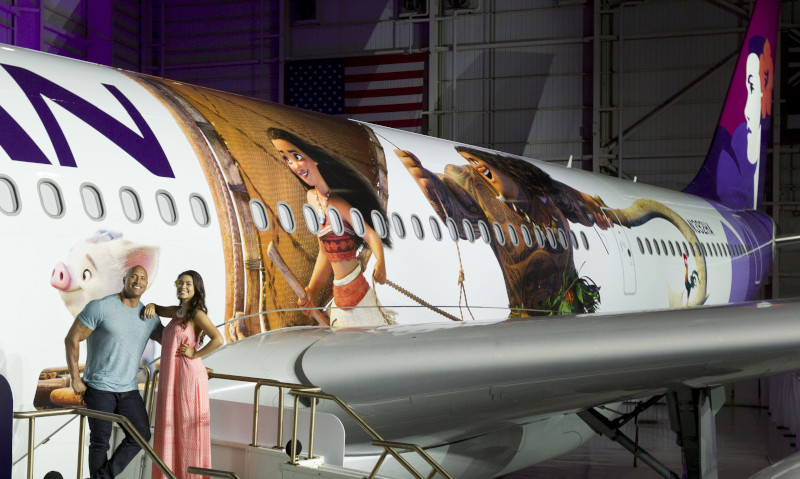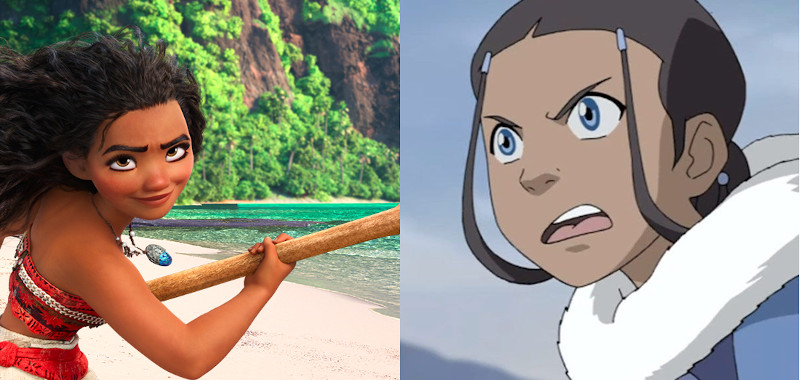Movie Review: Moana (2016) Was Quintessential Late-Stage Disney
writing · · 6 min read
So far, 2019 has seen the release of the new Dumbo, the new Aladdin, and the new Lion King—and a new Mulan, by the way, is in the works, too. All-mighty Disney used to inspire kids to sing about the “circle of life”; now they’ve got critics jeering cynically about the “circle of franchise reboots.” Et tu, Mickey? At least, Disney partisans can reassure themselves, creative bankruptcy is a relatively new look for the studio. In 2016, a year that wasn’t so long ago (best remembered, or forgotten, for a presidential election of biblical proportions), Walt Disney Animation released the surprisingly clever Zootopia, a thinly-veiled allegory for present-day identity politics and the millennial urban condition. Then November saw the release of Moana, a slightly-less-clever movie about a South Pacific teenage girl endowed with magical powers and a destiny to save the world.
People like me—which is to say, adult males in our early 20s—are not generally concerned with computer-animated movies made for children, much less brand-name Disney Princess flicks. In part, this is due to the widely held belief that animated films aren’t “real” movies, which I thought Toy Story had pretty thoroughly eviscerated over 20 years ago. Maybe anthropomorphic characters and exaggerated expressions aren’t your cup of tea, but animated movies still impart values and themes to millions of impressionable Western children, so they’re worth paying attention to. Personally, it’s almost for lack of a better alternative: Watching comic book heroes punch each other for three R-rated hours in post-9/11 America, fueling our collective fetish for over-the-top violence and domestic terrorism? That’s our idea of “mature” storytelling? But I digress.
Moana is, unfortunately, not the strongest argument for taking family movies seriously. It’s a meticulously animated film with plenty of passion evident in its creation, but it’s one that—like that one sitcom episode you’ve sworn you’ve caught six times already—struggles to recapture the magic of a first-time viewing; a slick, ray-traced imitator standing in the shadow of something bolder and more authentic. This movie has a lot going for it, not in the least because there is something immediately appealing about a story of a confident, plucky protagonist of color charting her course in a faraway oceanic paradise; but if—as Martin Scorsese informs us—blockbusters are like amusement parks, then Moana is rather like a third-rate Six Flags. It’s polished and professional and lots of fun for the locals, but it’s unmistakably playing second fiddle to bigger and meaner siblings.

A major liability is the writers’ affinity for the oh-so-postmodern notion that all stories are equally absurd, and therefore the only way to say anything original is to kick out the legs of the metaphorical stool upon which their own premise rests. As an illustrative example (heads up!—if you’re reading a review of a three year-old movie on some obscure personal blog, you probably deserve every spoiler coming to you), take Moana’s first attempt to sail past the reef. After nearly drowning herself, something that nearly results in her death, she confesses to Grandma Tala that her lifelong dream to explore the world—the dream she relished every time she cut “Ruling Motonui 101” class to sneak off and go gaze at the ocean—might, for Moana’s own sake and for the sake of her subjects, need to be shelved and buried for good. “Well, okay!” grandma bellows, with a sly grin. “What? You’re not going to talk me out of it?” Moana replies, in mock-disbelief; the twist of her head seeming to suggest, and what were you getting so worked up about, silly viewer?
Self-aware humor is par for the course in modern Disney, and since Moana is a fresh entry with no cultural baggage (unlike, say, the Star Wars movies), most of it works. But really, Hollywood, let’s not pretend as if deconstructing cliches from TV Tropes is some kind of elixir that turns pure formula into pure gold. Now that those elitist scriptwriters with their pretentious arts school degrees can no longer wow us with inventive stories, they poke fun at us for falling for make believe in the first place—but really, they’re just frustrated they’re stuck scripting a corporate softball like Jurassic World instead of the truly biting stuff like Blazing Saddles or Airplane!. After all, why won’t Disney let the world see Star Wars Detours? Because it risks too much collateral damage to “the brand” for the suits’ taste, even if the whole thing was fully produced and the digital computer models and voice samples are sitting idle in some Lucasfilm art vault. Yes, I’m bitter.
Mulan was not perfect, but its colorful cast—Mushu, Captain Shang, Shan Yu, even the horse—more than compensated for their mild offensiveness in terms of sheer entertainment value. Moana, by contrast, tries to get by with just two characters: Moana and Mau’i. You can write off the rest of the humans, who are essentially cardboard cutouts and backup dancers, and the villains, who rank at the very bottom of the Disney Villain Coolness scale. Since every line of the script was run through an “Oceanic Trust” of experts in Polynesian culture, the giant crab and the lava monster are most likely sourced from real myths—which I do appreciate—but as a consumer, well, sometimes the Disneyfied version is preferable to the real thing. Was Moana too cautious? Rumors persist of deleted plot points featuring temper tantrums and sibling relationships. Second-guessing these decisions would be like Monday-night quarterbacking, since we will never have the full story—but I can’t help but think, that might have been cool to see, you know?
The best parts of Moana are the soundtrack—which often sounds like the product of a Pacific cargo cult that worships “Let It Go,” but preserves enough of the movie’s emotional core to make for pleasant listening—and Auli’i Cravalho, whose energetic and boisterous performance as Moana is the show-stealer that saves the entire endeavor. Looking at Moana‘s behind-the-scenes, one imagines those voice acting veterans, who have long since sold their souls to the Hollywood machine (yes, that goes for the Rock, too), looking rather dumbstruck as the perky teenager plucked from Hawaii’s little islands schools them on acting and singing in a musical blockbuster. It’s nice to see Cravalho staying true to her Hawaiian roots, and generally avoiding acting jobs that have anything to do with Disney.
Moana, by the way, is no archetypal European Disney princess—no, she’s the spunkiest strong-willed, dark-skinned, H2O-manipulating female protagonist to hit the airwaves since Avatar: the Last Airbender‘s Katara, voiced by an authentic Hawai’ian who speaks Hawai’ian. Clearly, this is a good thing: Henceforth, Disney movies shall no longer telegraph insensitive ethnic stereotypes. The only trouble, as the crusty old journalists and politicians like to remind us, is that an animated movie with characters that look and behave like you is not quite the same thing as full economic parity with one of America’s most powerful and exploitative corporations. Double but: Any negative judgment against Disney has to be reconciled with the special Hawaiian version of Moana, recorded by a dang proud Auli’i Cravalho. So make of that what you will.

To watch Moana is to marvel at its hyper-photogenic world: the idyllic villages and playful wooden huts, the shafts of light darting beneath the lush palm canopies, and the warm glow of the sunset as it reflects off of the rock faces. Just keep a mindful eye out for the parts that… were apparently not motivated by story considerations. Moana’s dress, I’m told by real movie critics with vastly more fashion sense than I will ever have, was specifically crafted to sell direct-from-sweatshop lookalikes at Target, and I think the same could be said for the mischievous big blue jewel she hangs around her neck. Even the South Pacific setting is, to some extent, an ad for any one of the faraway vacation resorts Disney would be more than happy to sell you reservations for.
So the verdict is that Moana is a perfectly palatable movie, even if it’s not the unabashedly creative, progressive-minded triumph we’ve come to expect from Disney’s better days. And as the latest contender in the long battle for Asian and Pacific Islander (hey, that’s me!) representation in Hollywood, you could certainly do much worse. For one thing, you could be white Katara…
Rating: 3/4